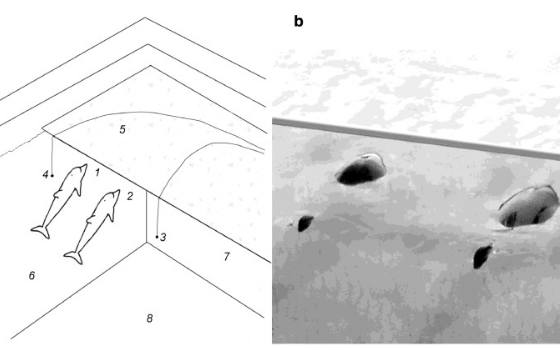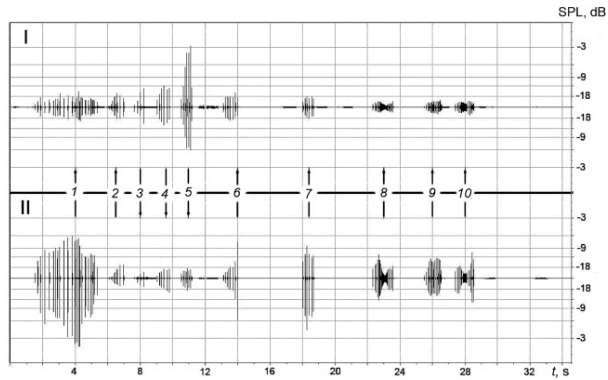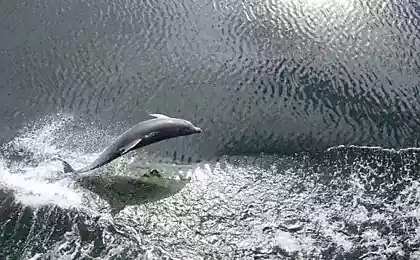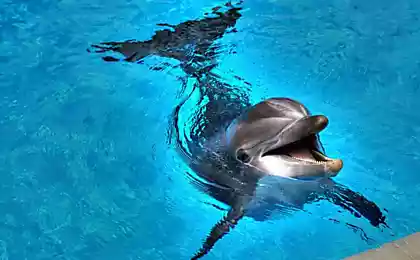580
Analysis of acoustic signals bottlenose dolphins showed the potential that they have developed spoken language

Researchers from the Karadag nature reserve, recorded "conversation" between two dolphins with the help they have developed an underwater microphone. After that, the recorded audio signal was carefully analyzed. Was also developed a system of analysis of acoustic signals of dolphins that allows you to distinguish between voices of different individuals.
The fact that dolphins communicate among themselves, for anybody not a secret. But what is the conversation, to find out failed. However, experts knew that dolphins use different types of clicks and whistles" in order to show their joy, boredom or loneliness. Now it turned out that the "speech" of dolphins, there are separate words, and the "it" presumably is much more complex than previously thought.
Changing the volume and frequency of clicks dolphins make up the words, and from words to whole sentences. In many ways, these conversations are similar to human speech. The researchers worked with two bottlenose dolphins by their nicknames Yasha and Jan. Their communication is constantly recorded, after which the scientists tried to put the whole conversation into its constituent elements. As it turned out, dolphins are able to listen carefully to each other. When he says one, the second listening, trying not to interrupt, and Vice versa.
The head of research Vyacheslav Ryabov said that the exchange of information the dolphins resembles a conversation between two people. "Every sound generated by one of the animals, different from the sound generated by the source," he says. Difference in the spectrum and frequency of pulsation. However, a number of combinations of sounds are not repeated. "We can assume that each ripple represents a phoneme or word from the language of dolphins."

Preferred Yasha and Jana position during a conversation
"The analysis of a number of "conversations" recorded during the experiments show that dolphins listen carefully to each other without interrupting. This gives us reason to think that animals understand speech of the interlocutor, and they need to listen to everything before you start "talking" to themselves" — continues scientist.
The brain of a Dolphin is no less complex than the human brain. While dolphins evolved much longer than humans — their history goes back 25 million years.
The researchers found that Yash and Jan can make sentences of five words or more. Sorry, the content of the speech is impossible to understand. Ryabov in this regard, said that now is the time to begin to communicate with dolphins, gradually improving their own communication skills with non-us entities.
"People need to take the first step to establishing a relationship with the first intelligent inhabitants of our planet, creating a device that can overcome the barriers that stand in the way of understanding and use of the language of dolphins," he says. Previously, experts have found that dolphins use more of the thousands of whistling signals. However, it remained unclear whether these mammals to directly speak with each other. That is not easy to apply the signals of the flock, I can do many animals, and purposefully to communicate with each other using advanced communication systems.

The group recorded sounds generated by dolphins Yana (the lower arrows) and Yasha (arrows pointing up) during one of the conversations
The work of the Russian scientists to study the way dolphins communicate not the first. The dolphins studied by many experts, but understanding the communication of these mammals while no one. However, in 2007, Australian scientists were able to identify separate sounds as signals. A certain combination of sounds means "I'm here, where is everyone?", "Hurry up", "Here is food".
Besides sounds, dolphins can communicate with gestures, using his fins.
Interestingly, the more complex the task facing the dolphins, the more these animals communicate with each other. Perhaps, scientists say, dolphins are discussing a solution to the problem faced. For example, in one of the cases previously observed by experts from Florida, USA, the dolphins started to communicate closely while trying to remove the cover from the canister.
Russian scientists claim that dolphins are, like humans, build words from individual phonemes. However, if a person is quite narrow bands of the spectrum for communication, dolphins spectral range is much wider (40 times). Therefore, we dolphins are more informative than the man. For the same unit of time a Dolphin can convey to the other person-a Dolphin much more information than the human person. The sound volume, click-through rates, the presence of whistling acoustic signals, the signal frequency is all that matters to Dolphin.
Vyacheslav Ryabov and his colleagues argue that the study was a thorough analysis of the sounds made by these animals. During analysis, scientists have studied how spectrum, the duration, the number of separate sounds and phonemes and the possible structure of Dolphin language. Scientists emphasize that their work is theoretical in nature.
However, the set of sounds that bottlenose dolphins communicate with each other, have much in common with human speech. This indicates the development of intelligence and consciousness of the dolphins. Their language is likely to be highly developed speech of a human. Scientists emphasize the need to create systems that could help to study the structure of Dolphin language. In addition to bottlenose dolphins, experts Karadag nature reserve studied the communication of toothed whales (Odontoceti). It turned out that this species also has a well-developed system of communication using sounds. Perhaps, scientists say, this language is not less complex and developed than that of the dolphins.
Research work "The study of acoustic signals and the supposed spoken language of the dolphins" was published in the journal "St. Petersburg Polytechnical University Journal: Physics and Mathematics (Nauchno-tekhnicheskie Vedomosti SPbGPU. Physico-mathematical science) (doi: 10.1016/j.spjpm.2016.08.004).
Source: geektimes.ru/post/280360/
What's wrong with Zelensky? With The "Evening Quarter"?..
Proven the authenticity of the Code of the Continent — the fourth of the surviving Maya Codex























